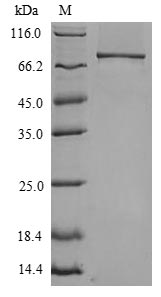The sequence encoding the 26-638aa of the Mouse Toll-like receptor 4 (Tlr4) was expressed in the yeast. Each product has fused a 6xHis-tag at the N-terminus for purification. The recombinant truncated mouse Tlr4 protein was purified by SDS-PAGE and got a purity of over 90%. The Tlr4 protein migrated to a molecular weight of about 75 kDa on the reducing SDS-PAGE gel. In addition to specific antibody production, this protein may be used in the immunological studies involved in Tlr4.
Tlr4 is a major pathogen recognition receptor (PRR) expressed on the cell surface of several immune cells including macrophages and dendritic cells. It is the exclusive family member that signals through both MYD88-dependent and MYD88-independent, TRIF-dependent pathways. Tlr4 signalings mediated via the above two manners are involved in the production of proinflammatory cytokines and the induction of the full innate immune response, respectively. Besides, Tlr4 is also associated with the pathogenesis of pro-inflammatory based diseases such as multiple sclerosis (MS).






